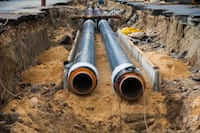
Copper clad steel (CCS) tracer wire combines the strength of steel with the conductivity of copper, making it a good choice for locating, pulling, and pipe bursting.
But what is CCS wire, how is it different from other types of tracer wire, and where is it used?
Copper clad steel is made by metallurgically bonding copper cladding to a steel core conductor using high heat and pressure. The result is a high break load tracer wire that can still carry a current for location purposes.
To prevent damage, manufacturers also apply high molecular weight polyethylene (HMWPE) or high-density polyethylene (HDPE) insulation. The result is a direct burial rated wire with abrasion, crush, and water resistance.
CCS wire has several types, including high strength (HS), extra high strength (EHS), stress relieved (SR), and pipe burst. The strength needed for the job depends on the break load you need.
For example, you wouldn’t use solid copper tracer wire for pipe bursting because it would easily break.
Compared to solid or stranded pure copper options, copper clad steel has several advantages.
Powerful Metal Combination
Steel is a strong alloy, giving the wire high tensile strength for drilling and pipe-bursting projects. The copper used to coat the steel core is highly conductive, making it easy for signals to pass through the cable.
Although other metals and alloys might be as strong or stronger than steel, they aren’t as cost-effective. Additionally, though aluminum is lighter than copper, it isn’t as conductive. More aluminum is needed to achieve the same conductivity, increasing gauge size.
More Cost-Effective Than Pure Copper
Steel is less expensive than copper, so it makes sense that CCS would be less costly than pure copper tracer wire.
The lower cost does come with a drawback, though. CCS isn’t as flexible as copper, making it harder for workers to manipulate.
CCS is Theft-Resistant
How often do we read about copper thieves breaking into homes, businesses, and construction sites to steal copper?
Copper is valuable, making it an attractive target. But steel – not so much. If a thief wanted to take CCS wire from a job site, it has little resale value at scrapyards. The steel core is also difficult to cut through using regular cutting tools.
Copper clad steel tracer wire comes in handy for many applications beyond locating underground utilities.
You can easily find CCS wire used across many projects, including the developing renewables industry.
Water and Sewer Pipe Applications
CCS wire can locate underground water and sewer pipes, but it also works well for grounding.
When used as a grounding wire, copper clad steel safely reroutes electricity during a surge or fault. As a result, workers face fewer shock risks.
Code enforcement may also require grounding systems as part of an installation, so check before starting your project.
Directional Drilling and Boring
Thanks to its steel core, CCS has more tensile strength than pure copper tracer wire.
Crews can attach copper clad steel wire to drill bits used for directional drilling to track the bit’s location as it digs. Because the bit is easier to find, drilling projects are more accurate with fewer risks to other underground assets.
Although CCS isn’t as strong as pipe bursting wire, it works well for lower break load projects where strength isn’t critical to the job.
Open-Cut and Pipe Bursting
Open-cut installation is the most common way to install pipes, cables, and underground assets.
When costs are a concern, open-cut projects tend to be less expensive per linear foot than other methods. Workers also have direct access to the utility, allowing them to precisely position the tracer wire.
For pipe bursting, workers connect a wire to a bursting tool. A machine then pulls the tool through the old pipe to break it. This work often requires a high break load, meaning standard copper or stainless steel options aren’t up to the task. CCS wire can withstand the machine’s pulling power without stretching or breaking.
Copper clad steel has many other applications beyond water and sewer projects.
Gas Utilities – CCS tracer wire can locate underground gas lines. The wire is also good for bonding and grounding purposes.
Buried Conduit Projects – Tracer wire is common for many underground tracing projects, and CCS is no different. It does the same thing as solid copper tracer wire at a more economical price.
Wind Farms – In some cases, CCS can have special corrosion-resistant insulation and jacketing applied for offshore wind projects.
Overhead Ground Wiring – CCS is great for grounding, as its copper layer allows current to safely flow through it. The steel core also helps with vibrations.
Messenger Wire – Although messenger wires don’t carry current, they are critical in overhead electrical installations. These wires support other overhead cables, preventing them from sagging.
Horizontal Directional Drilling – Copper clad steel’s break load makes it a good option for lower-resistance drilling projects. For pipe bursting, a bulked-up CCS wire with a 4,700 lb. breaking strength is used.
It may seem like copper clad steel can do it all, but it’s best to understand the project’s full scope before jumping in.
Research the application, learn what APWA-approved color(s) you’ll need, and what the environment is like. Every installation is different, and sometimes a particular wire doesn’t check all the marks or may be overkill. The environment and final installation location will also dictate any special attributes the wire’s insulation or jacketing may need.
Teams should also see if there’s a need for cost-effective options. Solid copper tracer wire can become expensive for extended runs, making CCS a worthy replacement.